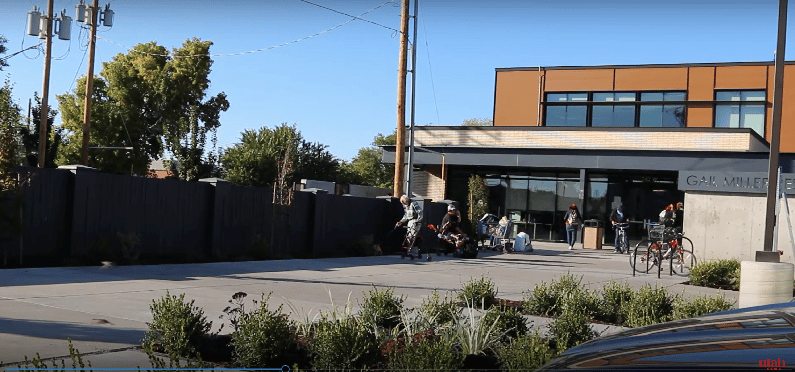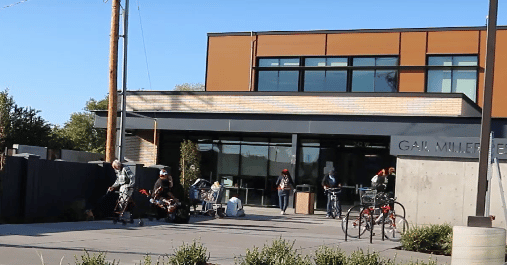
Back in 2016 amidst a surge in crime/lawlessness and homeless, both Salt Lake City and Utah state leaders devised a plan called Operation Rio Grande. State leaders on the “homeless task force” including Representative Greg Huges and then Lieutenant Governor Spencer Cox along with former Mayor Jackie Biskupski all decided to close the Road Home, (1,000-bed homeless shelter) and choose potential locations to build four new homeless resource centers.
The Ballpark Neighborhood community was one of the few to step up and accept the center and the recovering homeless with open arms. “We just decided that we were okay with their plans, and especially that they were going to take responsibility for the safety concerns of the neighborhood in their site-usage permit,” said Amy J. Hawkins, the Chairperson for the Ballpark Neighborhood Community Council.
But since the opening of the Gail Miller Homeless Resource Center crime including drug and sex trafficking have increased dramatically. Now the neighborhood has a nine-times greater murder rate than the rest of Salt Lake City. Hawkins says she feels sympathy for the homeless in the area, she also feels terrible that her neighborhood and neighbors are suffering and her friends are moving away. She says if the Bees end up moving, she will move as well.
Hawkins is also an Executive Board Member of the Pioneer Park Coalition, a group that supported the demolition of the old Road Home. Certainly, the old Road Home had many flaws but the major failure of homeless care today is the absence of beds and a failure to provide “wrap-around services”. The new resource centers replacing the downtown center have a total of 800 beds, the former Road Home had 1,000 beds. This math and logic do not work out especially considering that the overall population of Salt Lake City has nearly doubled since 2016. The Road Home’s proximity to other homeless resources including free warm meals, showers and indoor daytime shelter. This consolidation of services in one geographic area saved a huge amount of money. The former cost to operate the Road Home was $3 million per year. The new cost to operate the four resource centers is $15 million per year (not including the huge increases in overflow shelter costs). The increase in costs with the decrease in services and beds is endemic to the entire homeless resource services industry in Salt Lake City.
The four new Homeless Resource Centers were intended to be in-and-out, 90-day centers. Instead, today 70% of the beds in the resource centers are occupied by tenants who have been there for over a year.
The resource centers have also become magnets for drug and sex trafficking in the neighborhoods in which they operate. Even proponents of the resource centers admit there are major problems. They all say this is due to a massive shortage of caseworkers and resources. The huge shortage of caseworkers should come as no surprise according to PPC Executive Buchanan:
“People who have a Bachelor’s degree in social work or psychology working with schizophrenics and severely mentally ill people doesn’t make sense… It’s too difficult of a job with someone with a very limited skillset” said James Buchanan, Executive Director of the Pioneer Park Coalition on the Utah Stories show.
Drug addicts are not receiving the treatment they need. Severely mentally ill unsheltered homeless won’t have any options until the South Salt Lake Jon Huntsman Mental Hospital opens. But even when its 55 beds are ready, there will still be a shortage of beds to fulfill the needs of Utah’s most mentally ill. Keeping them in the shelters is highly problematic.
One unsheltered homeless woman camping on Main Street and 1100 South named Diane told me, “I would like to get off the streets into a shelter, but when I stayed at the shelter, all night long, three different women are crying out, making it impossible to sleep.” Diane’s complaints have been echoed by many other currently unsheltered homeless men and women we have spoken to. So instead, many homeless choose to remain unsheltered. Many of them wander the streets, and many more self-medicate on cheap meth and fentanyl. “Utah needs a big mental hospital to keep all of these [mentali ill people],” Diane says. It’s difficult to disagree.
RELATED CONTENT
Crime Rate Soaring in Salt Lake Neighborhoods with Homeless Resource Centers
Why More Homeless Spending Is Resulting in More Homeless People
Releasing Murderers in Utah Needs to Stop, Says Danielle Ahn
The $300 Million Utah Homeless Question
SUPPORT LOCAL JOURNALISM AND SUBSCRIBE TO PRINT MAGAZINE
Subscribe to Utah Stories weekly newsletter and get our stories directly to your inbox



